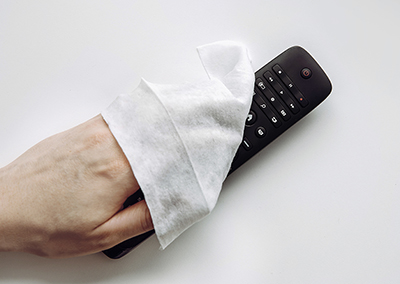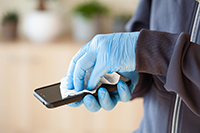 Spring cleaning is taking on a new urgency this year. Heeding coronavirus prevention guidance from Atlanta-based Centers for Disease Control and Prevention (CDC) and other health authorities, we’re all intensely cleaning and disinfecting our Georgia homes and workspaces, as well as personal items, in an effort to stem the spread of the virus.
Spring cleaning is taking on a new urgency this year. Heeding coronavirus prevention guidance from Atlanta-based Centers for Disease Control and Prevention (CDC) and other health authorities, we’re all intensely cleaning and disinfecting our Georgia homes and workspaces, as well as personal items, in an effort to stem the spread of the virus.
By now, we’ve all read or heard the admonishments to wash our hands thoroughly and observe social distancing to control the outbreak. But transmission of the virus can also occur by touching infected surfaces. The coronavirus is transmitted via respiratory droplets, and the CDC says that current evidence suggests it “may remain viable for hours to days on surfaces made from a variety of materials.”
To beat the bug, it’s time for some deep cleaning in the homes
most of us are now occupying 24/7.
To beat the bug, it’s time for some deep cleaning in the homes most of us are now occupying 24/7. This includes regularly disinfecting electronics and electric appliances that are getting more use. To help Walton EMC members do a thorough job, we’ve compiled these tips from experts.
1. Identify all “high-touch” areas.
The CDC suggests you clean and disinfect all commonly touched hard surfaces, which can be a breeding ground for germs.
- General – light switches, doorknobs/handles (interior and exterior), stair rails, countertops, all bathroom fixtures.
- Electric Appliances – refrigerator, microwave, oven and dishwasher handles/doors; coffee maker.
- Electronics – TV remotes, phones, tablets, laptops, gaming devices.Home office – desk, keyboard, mouse, printer, phone.
Note the areas you need to clean, so you won’t forget any. The CDC recommends disinfecting frequently touched surfaces daily.
2 Know the difference between sanitizing and disinfecting.
Sanitizing (reducing the number of germs) is not the same as disinfecting (killing germs). Different cleaning products require different amounts of “wet” (cleaning product in a liquid stage) time on a surface to reduce or kill germs. Rule of thumb: Sanitizing usually takes less time — sometimes just 30 or 60 seconds — while disinfecting can take up to 10 minutes, depending on the product.
There are plenty of options out there for cleaning and disinfecting,
but not all will kill the coronavirus.
3. All cleaning products are not created equal.
There are plenty of options out there for cleaning and disinfecting, but not all will kill the coronavirus, advises the U.S. Environmental Protection Agency.
In general, you can count on anything with the brand name Clorox or Lysol to do the job. Other options:
- Bleach is effective but harsh, so be careful when using it. To make a diluted bleach solution: Use 1/3 cup of bleach in one gallon of water or 4 teaspoons of bleach in one quart of water.
- Hydrogen peroxide, used directly from the bottle, can be used on hard, non-porous surfaces.
- Rubbing alcohol that is at least 70 percent alcohol is safe for all surfaces.
Do NOT use:
- Distilled white vinegar (or vinegar-based products).
- Vodka or other distilled spirits.
- “Magic” remedies advertised online or TV – This is a scam; there is no such thing currently available.
4. Clean, then disinfect.
No product can adequately sanitize or disinfect a dirty surface, so make sure you clean — even with plain soap and water or detergent — before you disinfect.
5. A quick swipe isn’t enough.
To decontaminate a surface, you can’t just swipe it. You’ve got to scrub it until the entire surface is wet, and then let it dry on its own.
It’s critically important to use enough of the disinfectant
and give it time to work.
It’s critically important to use enough of the disinfectant and give it time to work. For instance, here’s how Clorox says to disinfect hard, nonporous surfaces with its wipes: “Use enough wipes for treated surface to remain visibly wet for 4 minutes. Let surface dry.”
Check all cleaning product labels to know how long hard, nonporous surfaces must stay wet for the most effective germ killing. Because liquids evaporate, you may have to reapply a product multiple times to disinfect.
6. Be careful.
In your zeal to rid your home of germs, don’t forget these safety measures:
- Wear disposable gloves and throw them out after each use.
- Never combine disinfecting/cleaning products.
- Follow manufacturer’s instructions for application and proper ventilation.
- Rinse food contact surfaces with clear water and dry after disinfecting, unless the product label specifically says it's not necessary.
- Don't use expired products.
Because you probably touch it more than anything else,
your smartphone is a high-potential carrier of the virus.
7. Prioritize phone sanitizing.
Because you probably touch it more than anything else, your smartphone is a high-potential carrier of the virus. Sanitizing it should be a priority.
 Cleaning your phone thoroughly is not easy, though. There are all sorts of nooks and crannies, delicate glass and intricate protective cases. Plus, any sort of moisture could interfere with your phone’s function.
Cleaning your phone thoroughly is not easy, though. There are all sorts of nooks and crannies, delicate glass and intricate protective cases. Plus, any sort of moisture could interfere with your phone’s function.
Apple recommends a gentle wipe with a product that has 70 percent isopropyl alcohol. Remove the case so you can clean the entire phone. Then, sanitize the case too (FYI, some cases can be placed in the dishwasher.) After you’ve wiped down the components, allow them to thoroughly dry before reassembling.
8. Wipe down your workspace.
If you’ll be working from home for a while, take the time to thoroughly clean your new workspace. After all, some research suggests the average desk is contaminated with more germs than what’s found in the average public toilet.
To properly clean and disinfect your desk area, power down and unplug all electronics. Disconnect peripherals from the computer.
Unless otherwise noted, use disinfectant wipes for cleaning. Before use, squeeze wipe to remove any excess liquid that could drip down into openings and damage circuitry.
- Desktop: Clear all items, then thoroughly wipe down the entire surface. Allow cleaning solution to dry before moving items back into place.
- Keyboard: Clear any loose crumbs and dust from the keyboard by gently shaking it upside-down over a trashcan or spraying compressed air between keys. Wipe on and between keys. Pay extra attention to often-used keys such as the space bar and Enter key.
- Mouse: Clean all sides and the scroll.
- Laptop: Swipe across the touchpad.
- Monitor: Wipe the display with a microfiber cloth dampened with a diluted solution of mild dish soap and warm water. Rinse the cloth with clean water, squeeze out excess moisture, then wipe again to remove any soapy residue. Avoid using paper towels, cleaning rags, glass cleaners and other harsh chemicals.
- Accessories: Wash your coffee cup or water bottle in hot water daily. Use disinfectant wipes to clean items such as your stapler, tape dispenser, scissors and most-used pens. Don’t forget to clean all sides.